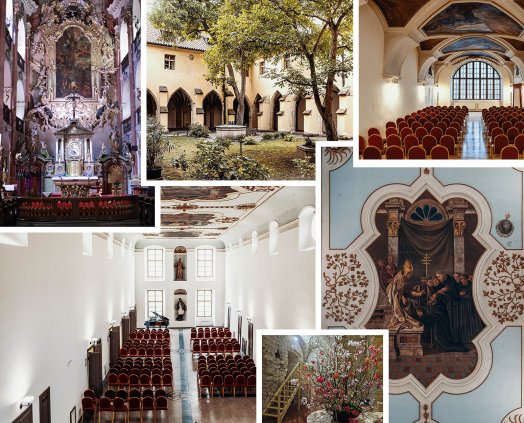
VISIT THE BASILICA OF ST. JAMES THE GREATER
As part of the extended tour of St. James' Basilica
and the Minorite Friary in Prague, you will see:
-
the basilica,
-
the Romanesque foundations of the friary
-
the ground floor, the gardens,
-
and the first floor, where the largest summer refectory among European friaries is located.
The Basilica of St. James the Greater is a monastery church located in Prague's Old Town on Malá Štupartská Street, halfway between Old Town Square and Republic Square. It is one of the largest churches in Prague, originally Gothic and later rebuilt in the Baroque style.
The church's current appearance has been preserved without significant changes since its reconstruction in the 17th century. The only remaining Gothic element is the eastern clock tower. The overall layout refers to the Jesuit churches of Il Gesù in Rome and St. Ignatius in New Town, with the sole exception of the elongated choir, which remains from the original building, albeit shortened by several meters. On the north side, the church is adjoined by a monastery convent and a Gothic sacristy with a four-bay cross vault.
You can admire the facade of the church, which is in the classicizing Baroque style with a single tower on the south side. The north tower was not restored after the fire of 1689. The attic of the facade is decorated with statues of St. Joachim, St. Anne, the Virgin Mary, and St. John, and there is a statue of the Savior on the gable. The austere facade is dominated by huge stuccoes of St. Francis, St. James, and St. Anthony of Padua by Ottavio Mosta from 1695–1701, which add a Spanish touch to the church.
The interior of the church consists of a simple basilica with tribunes. The interior is literally overflowing with furnishings, including 21 altars. It houses the second largest collection of altar paintings by Petr Brandl. Another interesting feature is the suspended pulpit, supported by a massive lion. Among the interesting features is a plaque set into the wall in the north aisle above the entrance to the cloister, which dates from 1615 and bears a warning from the butchers that anyone who endangers the church will be cut to pieces. During repairs, small Gothic elements and parts of the masonry were uncovered in some places of the three-nave church.
The current Baroque vault is barrel-shaped with lunettes. The individual fields of the vault feature frescoes by the Kadaň painter František Voget from 1736, depicting scenes from the life of the Virgin Mary, and in the choir, a celebration of the Holy Trinity. The original Gothic vault was 5 m higher. The choir is separated from the nave by a triumphal arch with stucco decoration and the emblem of the Friars Minor, depicting the crossed bleeding hands of Christ and St. Francis.
The Baroque wooden architecture is decorated with marble, and the figure of a lion with a cartouche bears the chronogram 1714. On the roof is a statue of God the Father and Christ the Savior among angels, below them are statues of St. Louis of Toulouse, St. Francis Seraphine, St. Bonaventure, and St. Anthony of Padua.
The wooden six-seat benches are Baroque, from the first quarter of the 18th century. Under the choir loft stands a single-piece bench from the early 18th century, with carved details and the alliance coats of arms of Václav Josef Lažanský of Buková and his wife Marie Gabriela, née Černínová of Chudenice.
An overview of twenty-one unique Baroque altars and statues in the chapels.
- The Altar of the Holy Cross on the north wall of the choir has various parts. The Crucified Christ is Baroque
from around 1730, while the mourning Virgin Mary with St. John dates from the mid-18th century. - On either side of the choir are the chapels of St. Francis Seraphim
(on the north side) and St. Anne (on the south side, with Baroque wood carvings from the workshop of František Antonín Weiss). - Altar of St. Agnes of Bohemia
- Altar of St. Anthony of Padua
- Altar of the Assumption of the Virgin Mary
- Altar of the Flight of the Holy Family into Egypt
- Altar of the Visitation of the Virgin Mary, the main painting of the Visitation and the painting of the Baptism of the Lord in the superstructure are the work of Petr Keck († 1730)
- Altar of St. Joseph, painting of St. Joseph with the infant Jesus in his arms, painted by Petr Brandl.
- Altar of St. Wenceslas, painting of the Murder of St. Wenceslas painted by Petr Brandl,sculptures of St. Vitus and Ludmila carved by Matěj Václav Jäckel
- Altar of St. Valburga with a painting of St. Teresa of Ávila by Jan Kryštof Liška
- Altar of Our Lady of Joy with a painting by Hans von Aachen
- Altar of St. Dismas
- Altar of St. John of Nepomuk
- Altar of the Holy Family
- Altar of the Holy Cross
- Altar of All Saints, painting by Petr Brandl
- Altar of St. Florian
- Altar of St. Jude Thaddeus
- Altar of St. Thecla
- Ecce homo altar
- The Holy Trinity altar, a portal retable, was carved by Marek Nonnenmacher around 1710, the painting inside was painted by Josef Mathauser (1890), and the Baroque statue of Our Lady of Sorrows was added by František Geiger.
 English
English
 Čeština
Čeština